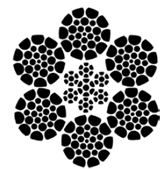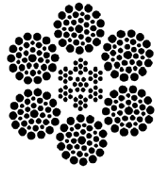Download Our Latest Product Catalog
Specialty Strands - Underwater Wire Ropes
- Rotary drill lines — 6x19 Seale (refer to 6x19 Classification)
- Plastic-infused drill lines — BXL
- Tubing lines — 6x26 Warrington Seale or 6x25 Seale (refer to 6x19 Classification)
- Specialized tubing lines — 6-Pac, Super-Pac
- Sand and swab lines — 6x7 Classification
- Well measuring line
- Well servicing line
- Mooring lines — 6x37 and 6x61 Classifications

6x19 Class Wire Rope
Strands: 6
Wires per strand: 19 to 26
Core: IWRC or fiber core
Standard Grade: Purple Plus
Lay: Regular or Lang
Finish: Bright or galvanized
The 6x19 Classification of wire rope is the most widely used. With its good combination of flexibility and wear resistance, rope in this class can be suited to the specific needs of diverse kinds of machinery and equipment. The 6x19 Seale construction, with its large outer wires, provides great ruggedness and resistance to abrasion and crushing. However, its resistance to fatigue is somewhat less than that offered by a 6x25 construction. The 6x25 possesses the best combination of flexibility and wear resistance in the 6x19 Class due to the filler wires providing support and imparting stability to the strand. The 6x26 Warrington Seale construction has a high resistance to crushing. This construction is a good choice where the end user needs the wear resistance of a 6x19 Class Rope and the flexibility midway between a 6x19 Class and 6x37 Class rope.

BXL
Strands: 6
Wires per strand: 19 to 36
Core: IWRC
Standard grade(s): Purple Plus
Lay: Regular or Lang
Finish: Plastic-infused
BXL is infused with a specially- engineered polymer, creating a well-balanced matrix. BXL is recommended for numerous hoist, marine and logging rope applications. BXL provides: Fatigue Resistance. Improved fatigue resistance is derived from the cushioning and dampening effect of the polymer on the wires and strands. BXL also evenly distributes stresses which may lead to fatigue breaks.
Abrasion Resistance. The polymer acts as a barrier between the individual strands, preventing penetration of any adverse material. BXL distributes and reduces contact stresses between the rope and sheave, reducing wire rope wear.
Resistance to multilayer.
Drum Crushing. BXL’s smooth profile evenly distributes crushing pressures from the overlying layers of rope in multilayer drum winding applications.
Extended sheave and drum.
Service Life. BXL minimizes corrugation and wear normally associated with standard rope usage by restricting water and dirt penetration and eliminating pickup of abrasive materials.
Clean Handling. The exterior rope surface is free from the grease normally applied to standard ropes.

6-PAC
Strands: 6
Wires per strand: 19 to 36
Core: IWRC
Standard grade(s): Royal Purple
Lay: Right Regular
Finish: Bright
6-PAC is recommended for use where the rope is subjected to heavy use or where conditions are extremely abusive, such as offshore pedestal, crawler and lattice boom equipped truck crane boom hoist applications. 6-PAC is also recommended for winch lines, overhead cranes, multipart hoist lines where rotation-resistant ropes are not required, and other applications where flexibility, high strength and resistance to crushing are important, and a cost-effective 6-strand rope is desired.
6-PAC provides:
Fatigue Resistance. Improved fatigue properties are derived from the combination of 6-PAC's flexible constructions and the compacted strands. The compacted strand surface minimizes the interstrand and interlayer nicking that take place in standard 6-strand ropes.
Abrasion Resistance. 6-PAC's compacted strand design provides improved abrasion resistance as compared to standard 6-strand ropes because of the increased wire and strand surfaces contacting sheaves and drums.
Flexibility. 6-PAC's design provides increased flexibility, making it easy to install, and 6-PAC also offers better spooling at high line speeds.
Resistance to multilayer.
Drum Crushing. 6-PAC dramatically increases the amount of wire contact with the drums and sheaves, reducing the wire rope, sheave and drum wear normally associated with standard wire rope.
Damage at the crossover points is also reduced.

6x7 Class Wire Rope
Strands: 6
Wires per strand: 7
Core: Fiber core
Standard grade(s): Purple
Lay: Regular or Lang
Finish: Bright or galvanized
This construction is used where ropes are dragged on the ground or over rollers, and resistance to wear and abrasion are important factors. The wires are quite large and will stand a great deal of wear. In fact, this construction is sometimes called “coarse laid” because of the large wires. The 6x7 is a stiff rope and needs sheaves and drums of large size. It will not withstand bending stresses as well as ropes with smaller wires. Because of the small number of wires, with the resulting higher percentage of load carried by each wire, a larger factor of safety should be considered with 6x7 ropes than with ropes having a larger number of wires.

6x36 Class Wire Rope
Strands: 6
Wires per strand: 27 to 49
Core: IWRC or fiber core
Standard Grade: Purple Plus
Lay: Regular or Lang
Finish: Bright or galvanized
The 6x36 Class of wire rope is characterized by the relatively large number of wires used in each strand. Ropes of this class are among the most flexible available due to the greater number of wires per strand, however their resistance to abrasion is less than ropes in the 6x19 Class. The designation 6x36 is only nominal, as in the case with the 6x19 Class. Improvements in wire rope design, as well as changing machine designs, have resulted in the use of strands with widely varying numbers of wires and a smaller number of available constructions. Typical 6x37 Class constructions include 6x33 for diameters under 1/2", 6x36 Warrington Seale (the most common 6x37 Class construction) offered in diameters 1/2" through 1-5/8", and 6x49 Filler Wire Seale over 1-3/4" diameter.


